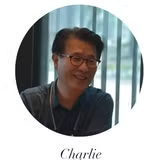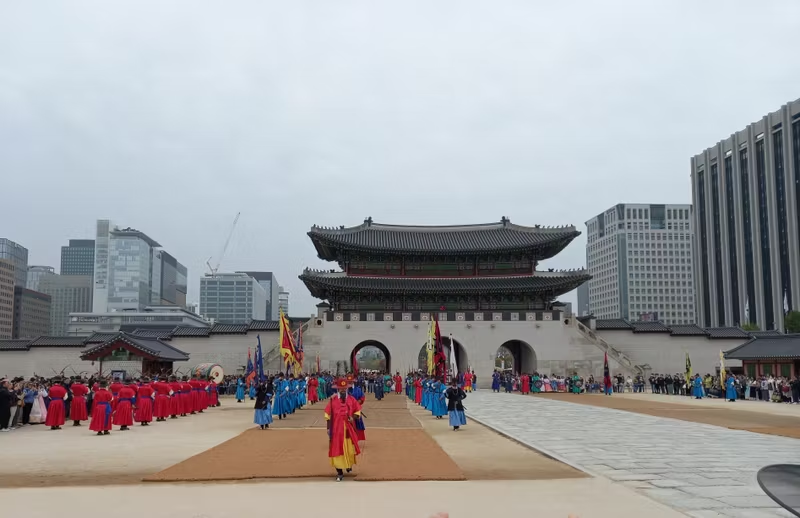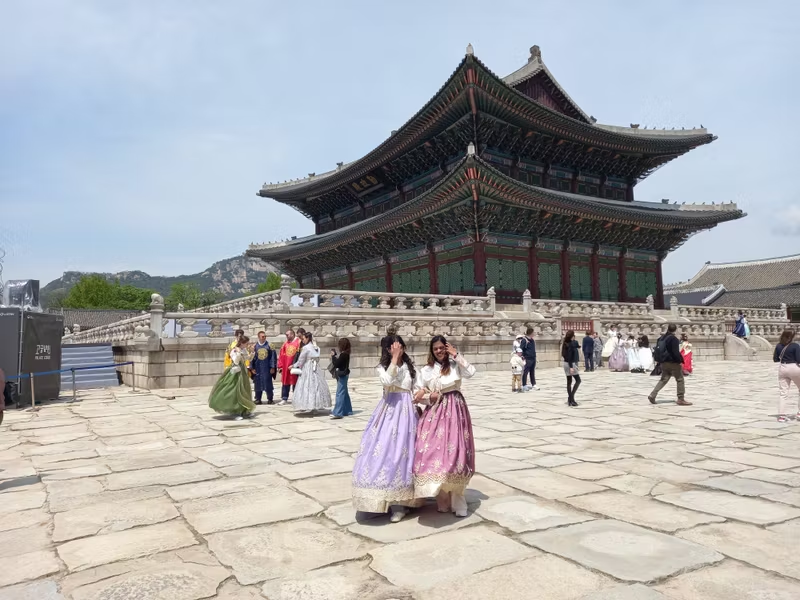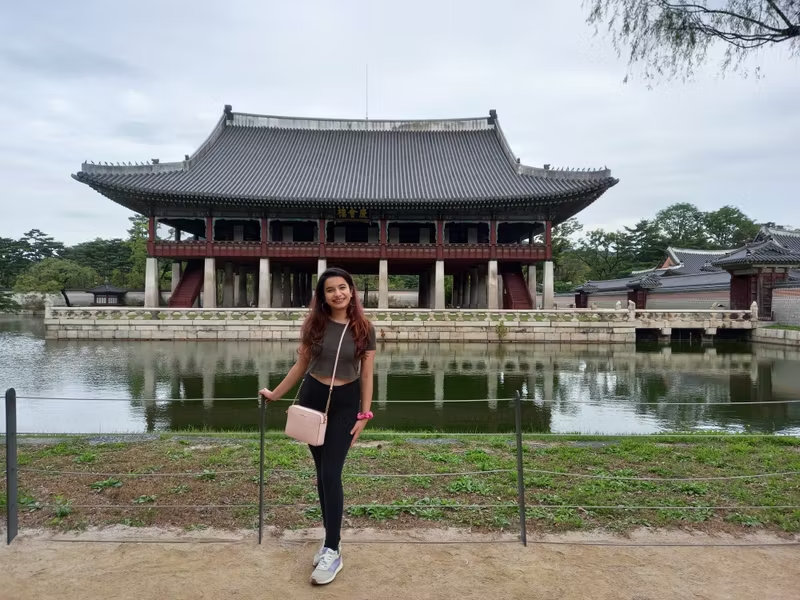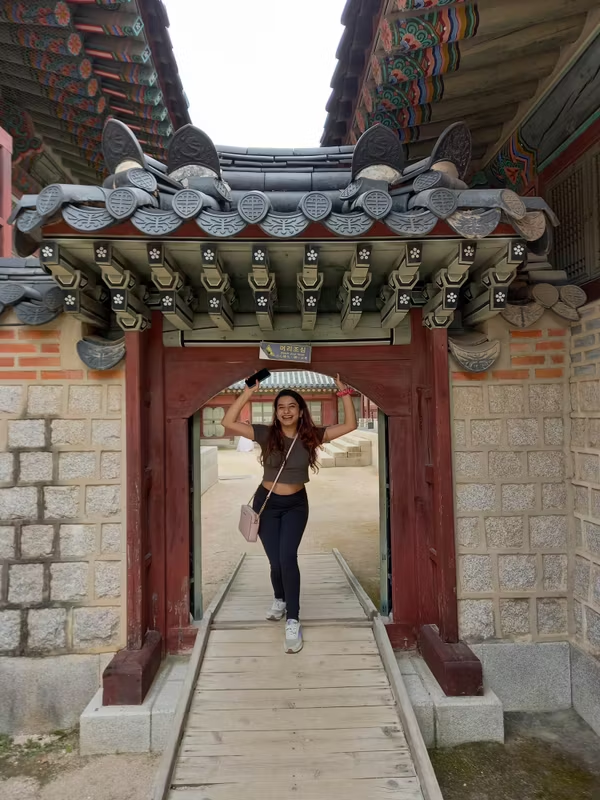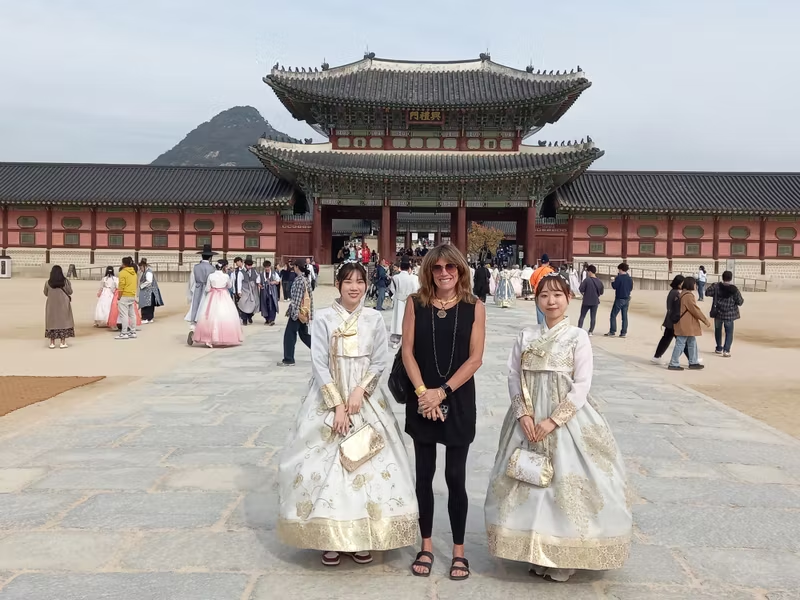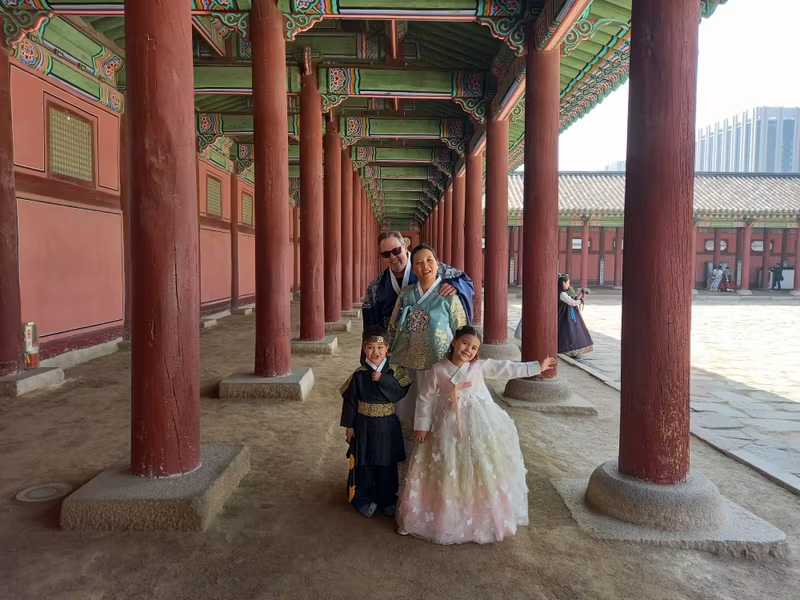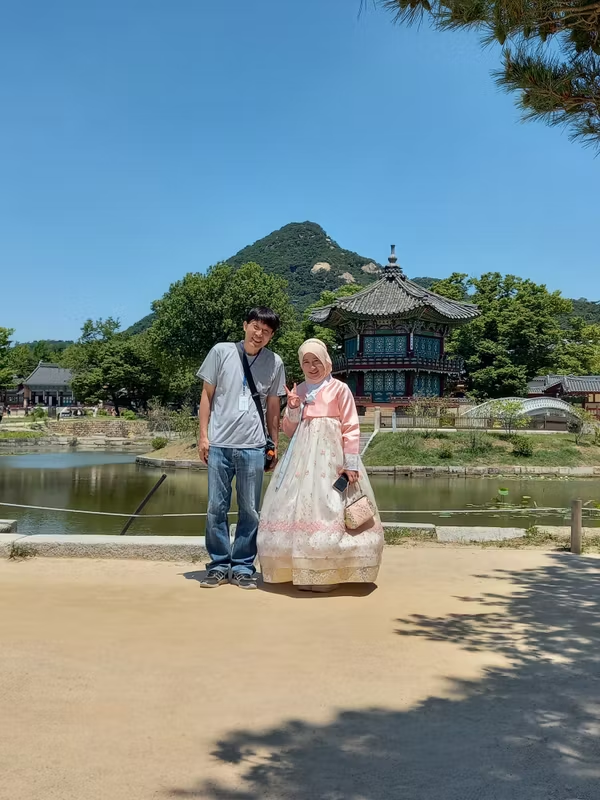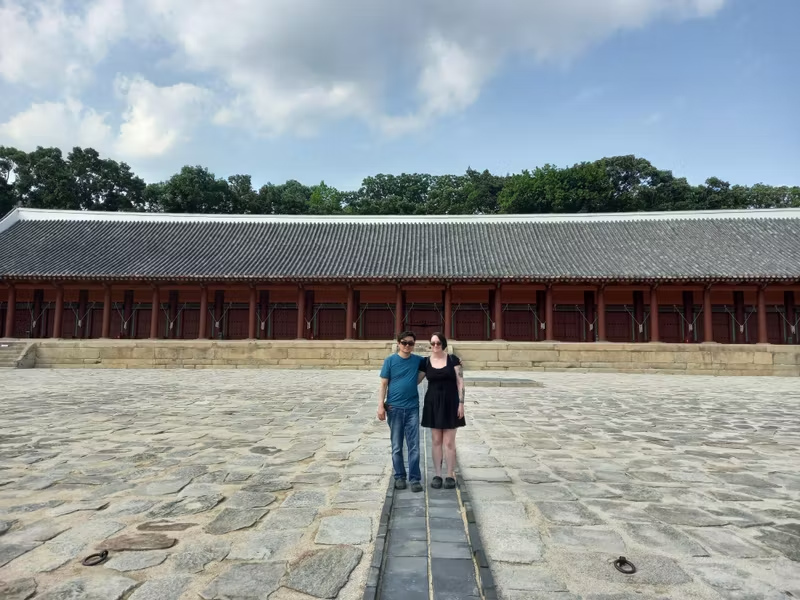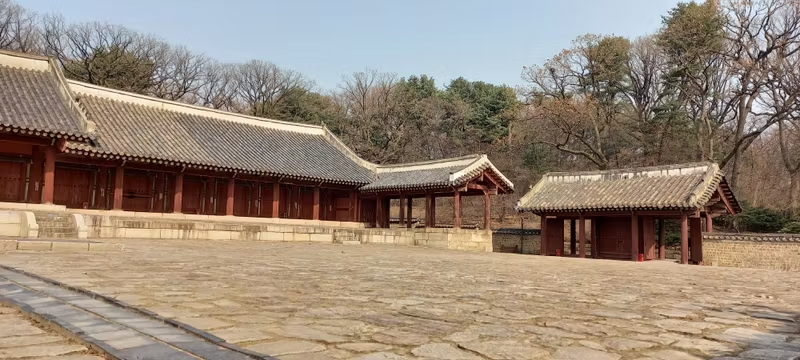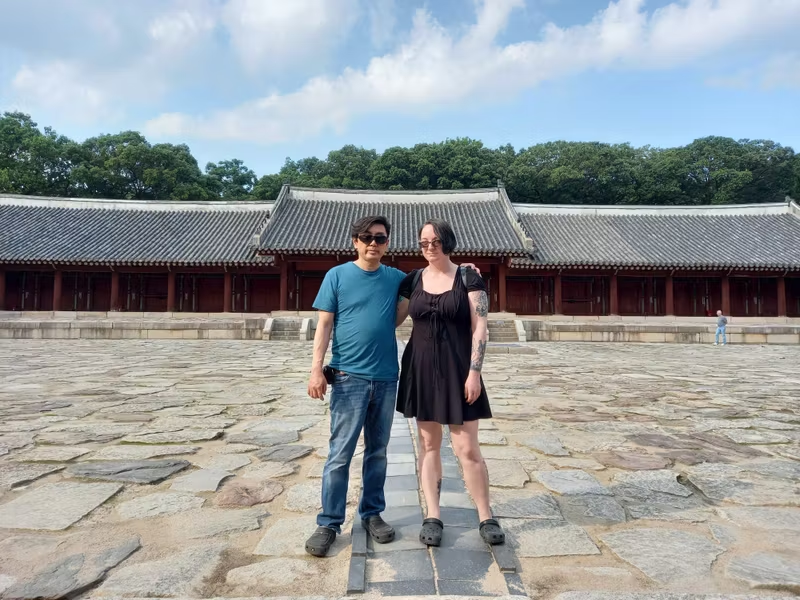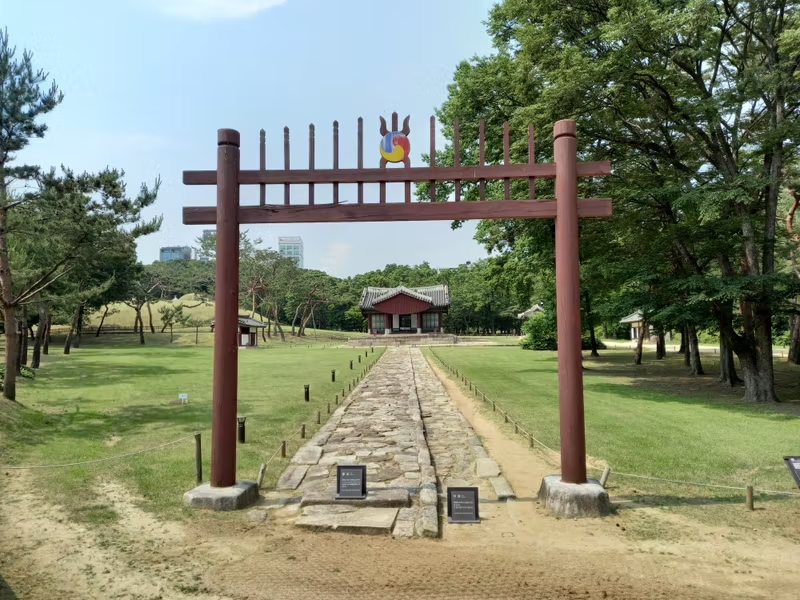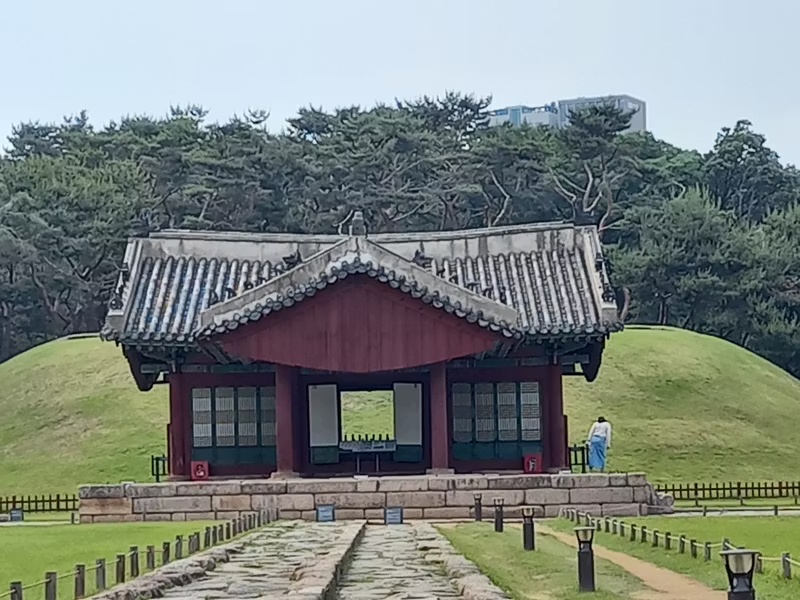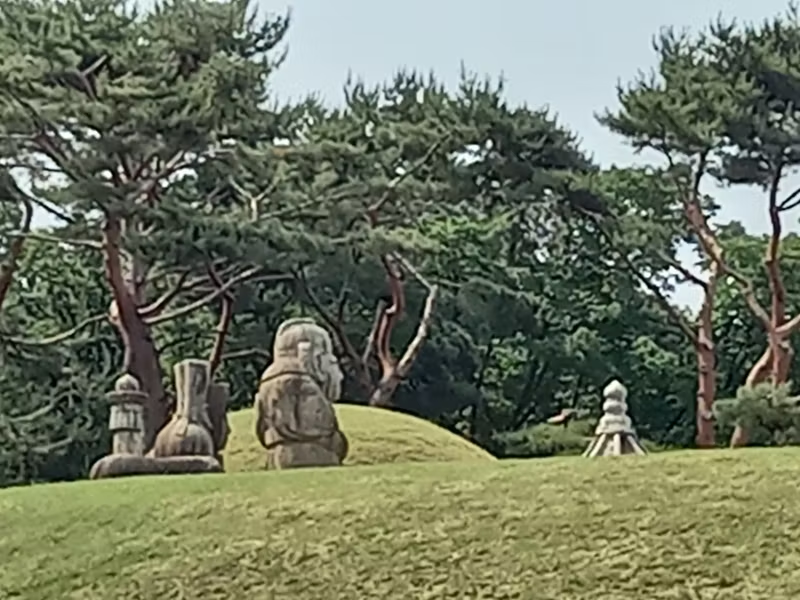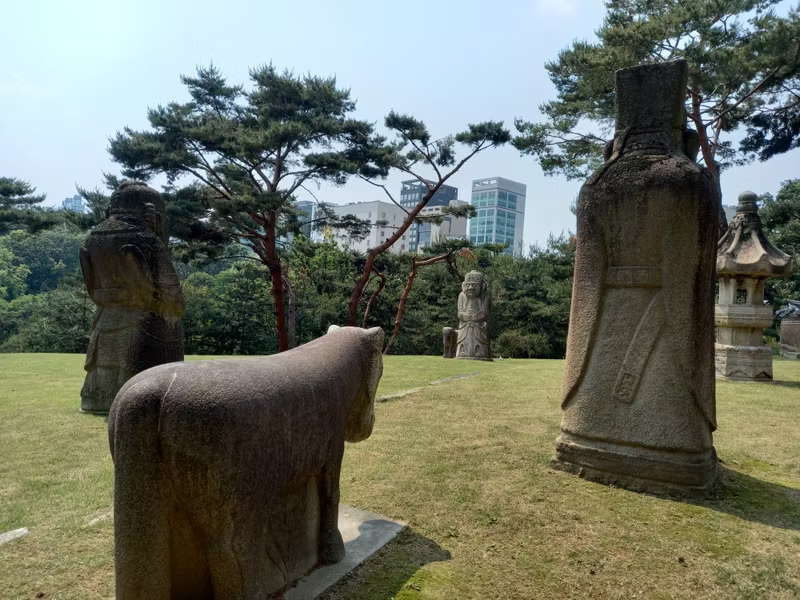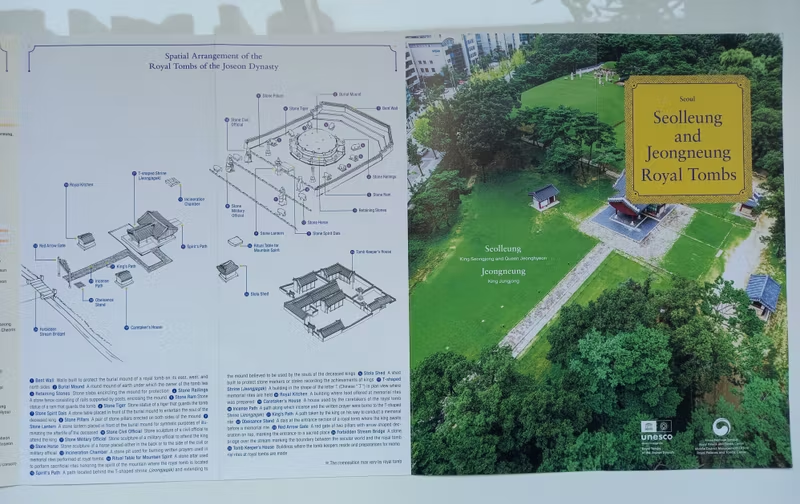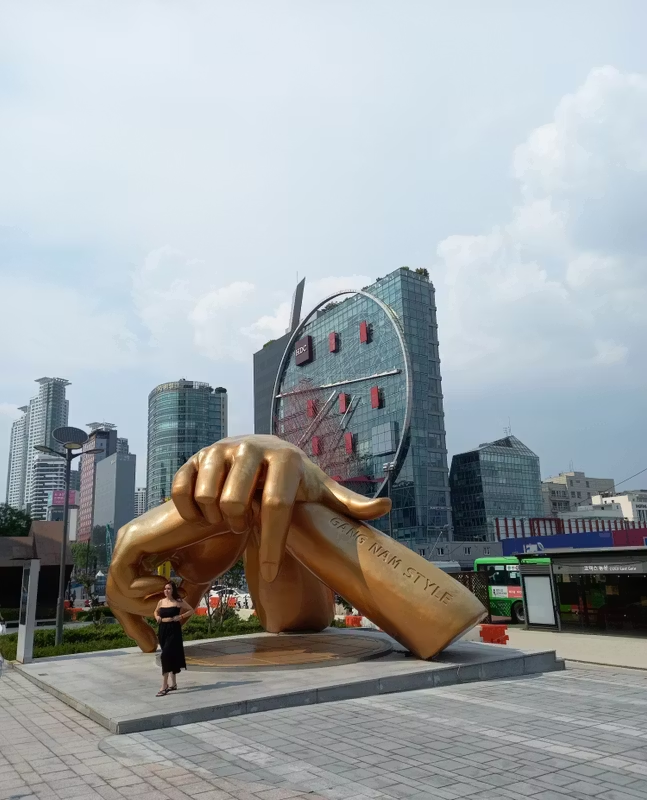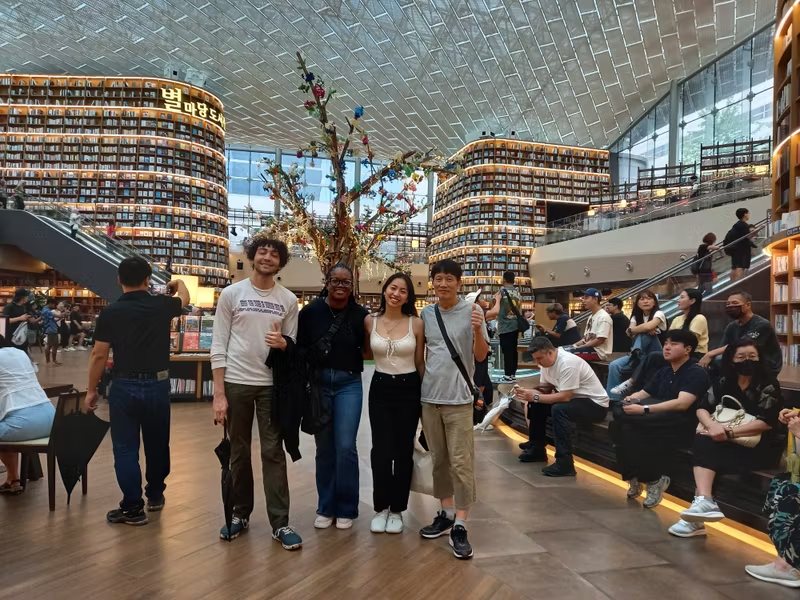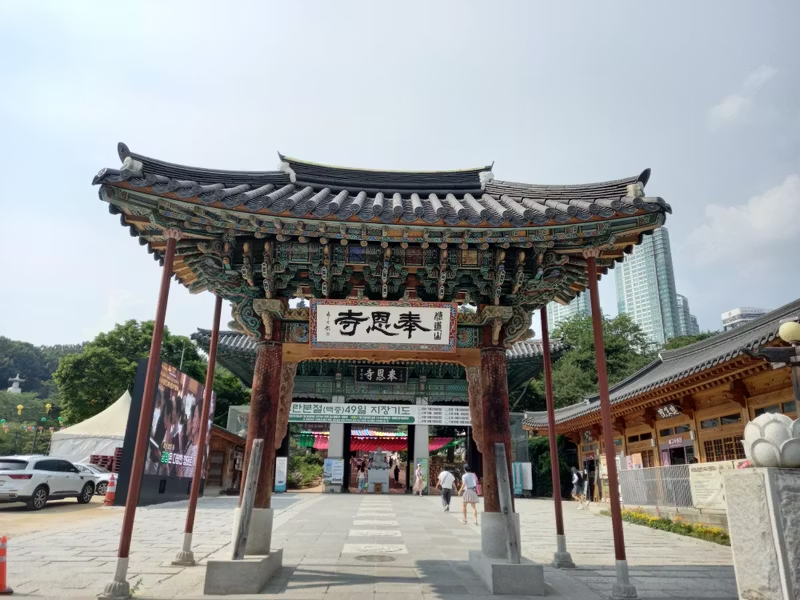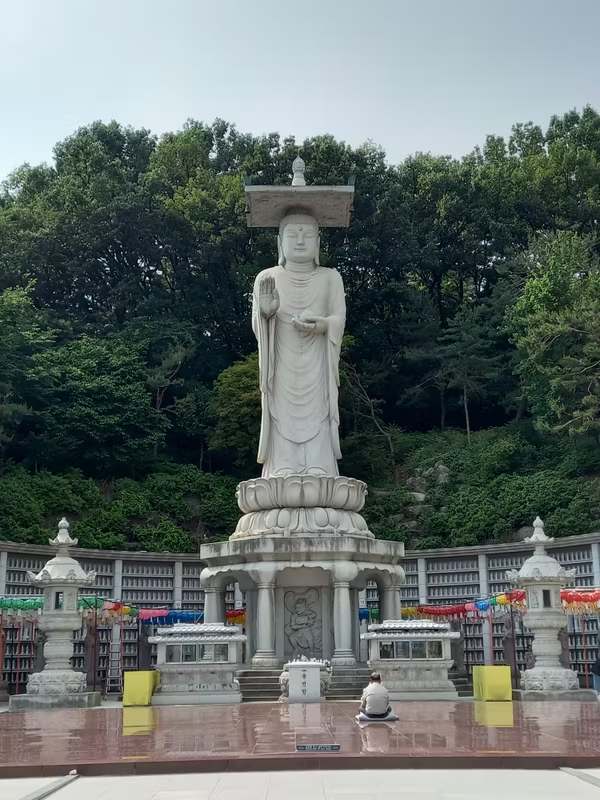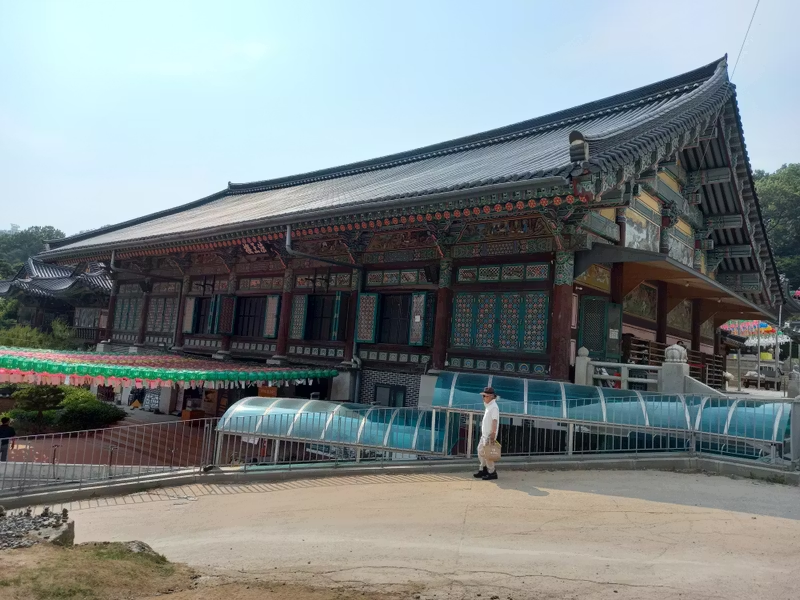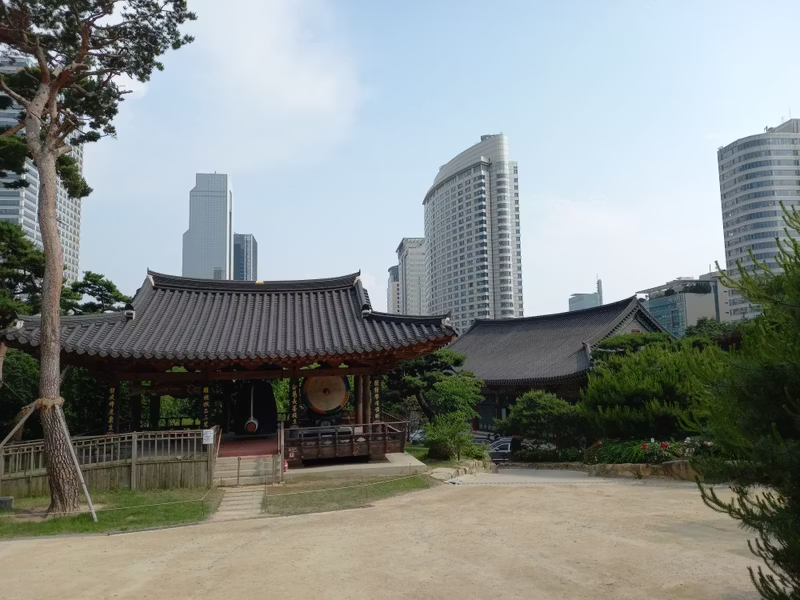Gyeongbokgung–Jongmyo Shrine-Seonjeongneung Royal Tombs-COEX-Bongeunsa Temple
Enjoy Korea's authentic Confucian architecture & landscape at Gyeongbokgung Palace, Jongmyo Shrine, Seonjeongneung Royal Tomb & Bongeunsa Temple, and Seoul's modern city landscape in Gangnam-COEX.
Gyeongbokgung is main palace of Joseon for national governance and living of king, representing unique palace architecture of Korea's Confucian culture.
Royal Shrine & Tombs are palaces of deceased kings & queens of Joseon Dynasty, representing Confucian ontology.
COEX & Bongeunsa Temple in Gangnam.
Itinerary
This itinerary can be customized to meet your needs and preferences. Send me a message with your requests!
Meeting Point
Gwanghwamun square - Statue of King Sejong statue
- Center of downtown Seoul, Front of Gyeongbokgung palace subway station of line# 3 & 5
Gyeongbokgung palace
Tour to Gyeongbokgung Palace.
Gyeongbokgung is 1st must-see architectures in Korea, and Gyeongbokgung is the most beautiful place in Korea.
Jongmyo Royal Ancestral Shrine
11:30~11:50: Moving to Jongmyo Shrine by subway
12:00~13:00: Tour to Jongmyo Shrine
Jongmyo is Royal Ancestral Shrine where spirit tablets of kings and queens of the Joseon Dynasty (1392-1910) are enshrined and descendants perform ancestor memorial services.
Lunch
13:00~13:30: Lunch at Jongno street
Seonjeongneung Royal Tombs
13:30~14:30: Moving to Seonjeongneung Royal Tombs by subway
14:30~15:30: Tour to Seonjeongneung Royal Tombs
Royal Ancestral Tombs are called God’s Garden!
There are total of 42 royal tombs of Joseon Dynasty, registered on the list of UNESCO World Heritage Site, since 2009.
Royal Tombs show unique architectural & landscaping styles and sculptures with supreme aesthetics & artistic value created by the best craftsmanship of the time.
Seonjeongneung are Royal Tombs for King Seongjong and Jeongneung.
COEX
15:30~16:30: Moving and tour to COEX
Tour to COEX mall, Star Filed Library, Gangnam style staute
Bongeunsa Buddhist Temple
16:30~17:30: Moving and tour to Bongeunsa Buddhist Temple
In the Joseon Dynasty, Bongeunsa temple was Neungchim Temple to protect Seolleung, the tomb of King Seonjong. For this reason, the temple was renamed Bongeun, which means "to recieve the benevolence.
Ending Point
Samsung station of subway line#9
Want to personalize this tour?
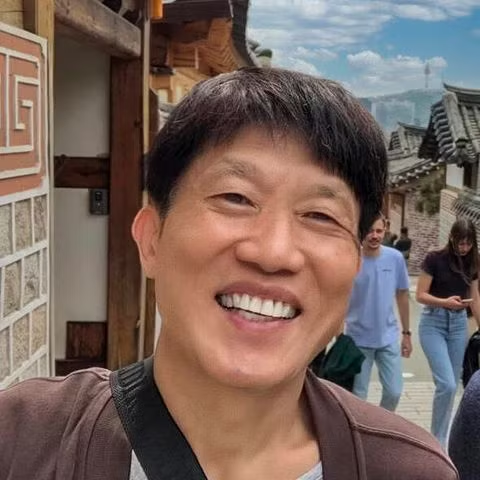
This tour can be customized to meet your needs and preferences. Click below to send me a message with your requests.
Inclusions & Exclusions
Guide fee
1. admission ticket for Gyeongbokgung palace, Shrine
ticket price for palace: $2/person
ticket price for shrine: $0.8/person
2. Expense for transportation: Moving by subway and bus
3. Expense for water, drink and food
Tour Important Information
Tour to the most beautiful architectures and gardens of Korea along with fascinating modern metropolitan landscape of Seoul Gangnam area.
"Gyeongbokgung palace - Jongmyo Shrine - Seonjeongneung Royal Tombs - COEX - Bongeunsa Temple"
1. Gyeongbokgung is the most beautiful place and 1st must-see architecture in Korea. Gyeongbokgung was built in 1395 as main palace and monumental architecture that represent Confucianism, Korea's cultural identity. It is largest and the only palace built on flat land and according to traditional palace structure.
2. Jongmyo Royal Shrine and Tombs of Joseon Dynasty
In Confucianism, there are two types of soul; baek controls one’s body and hon controls one’s mind. When people die, two souls go out of body and are divided. Hon returns to heaven, and Baek returns to earth.
Ancestral ritual was practice of Confucian propriety to thank ancestor for grace and connect people to tradition, history, family to feel identity, stability & belonging and build unity and cooperation.
To commemorate ancestors, Asian people built the grave for body of the dead, and made spirit tablet where Hon lingers around.
1). Jongmyo – Royal Ancestral Shrine:
Jongmyo is one of the most beautiful and must-see architecture of Korea with Gyeongbokgung.
Jongmyo is Royal Shrine where spirit tablets of kings and queens of the Joseon Dynasty are enshrined and descendants perform ancestor memorial services.
Jongmyo Shrine was listed as a UNESCO World Heritage Site in 1995.
2). Seonjeongneung - Royal Tombs of Joseon Dynasty
Royal Ancestral Tombs are called God’s Garden!
There are total of 42 royal tombs of Joseon Dynasty, registered on the list of UNESCO World Heritage Site, since 2009.
Royal Tombs show unique architectural & landscaping styles and sculptures with supreme aesthetics & artistic value created by the best craftsmanship of the time.
Seonjeongneung are Royal Tombs for King Seongjong and Jeongneung.
3. COEX-Star Field library - Bongeunsa Buddhist Temple
Important message from the supplier
My primary tourist destination is Seoul and metropolitan area, consisting of 5 palaces, Royal Ancestral Shrine, Bukchon Hanok Village, National Museum of Korea, War Memorial of Korea and other museums & galleries and contemporary architectures, and Namsan Mt. with N-Seoul Tower, traditional & trendy market places such as Gwangjang market & Hondae street, and also Korean Folk Village & DMZ tour.
Cancellation Policy
- Free cancellation - 8 days prior to meeting time
- 50% Refund - 3 to 7 days prior to meeting time
- No Refund - Within 2 day(s) prior to meeting time
About Tour Guide Paul K.
Hello everyone, I am Paul, a state-licensed English tour guide in Seoul. I am professional tour docent with proven record track of over 200 tours for international tourists.
Seoul is a fascinating destination that seamlessly blends the traditional with the modern.
My tour is to explore Korea’s unique cultural identity and beauty!
Center of tour is architecture. Architectural style represents spirit of times. We can see as much as we know. For example, without knowledge about Christianity, the spirit of medieval Europe, we cannot fully appreciate beauty and value of Romanesque and Gothic architecture, but are just fascinated by its superficial beauty.
Confucianism is the spirit of Joseon Dynasty. Confucianism is Korea's cultural identity, that is basis for Korean traditional architecture.
Based on understanding of Confucianism, your appreciation will create intense impression and long-lasting memory of your tour in Korea. I am the only tour docent-guide in Korea who introduces Korean traditional culture based on Confucianism.
My primary tourist destinations are focusing on Seoul and metropolitan area, consisting of 5 palaces, Royal Ancestral Shrine, Bukchon Hanok Village, National museum of Korea, War Memorial of Korea, other museums & galleries and contemporary architectures, and Namsan Mt. with N-Seoul Tower, traditional & trendy market places such as Gwangjang market & Hongdae street, and COEX-Starfield library & Bongeunsa Buddhist temple & Sunjeongneung Royal Tomb in Gangnam area, and also Korean Folk Village & DMZ tour in neighboring cities.
Alongside, I am specialist for hiking to Bukhansan Mt. and Inwangsan Mt. that are located in downtown Seoul, where you can enjoy beautiful natural sceneries and stunning view of Seoul.
With my hands-on experiences and deep knowledge of Korea's culture & history, you can discover true discoveries in Korea.
Thank you for your interest!
As your guide, I hope to see you soon in Seoul!
Reviews
Albertus S.
“Full day tour with Paul”
Paul is very knowledgeable and passionate about the history and culture of his country and he gave us a profound introduction of Confucianism.

Paul K.
Appreciation of traditional architecture, works of art and crafts require background knowledge. Based on the background knowledge of Korean traditional culture, your appreciation can create an intense impression and long-lasting memory of tour. I introduced core ideas of Confucianism and the Confucian principles that are the basis of Gyeongbokgung architecture. I am only tour docent in Korea who introduce Korean history and culture based on Confucianism.
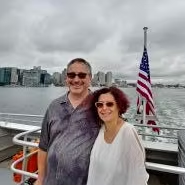
Josh W.
“Paul was an outstanding guide!”
When Paul started put with a lesson in Confucianism and the history of Korea, my wife and I didn't quite know what to think. When we got to the first palace, everything came together and made great sense. Our day with Paul was educational (a tenant of Confucianism), fun, and delicious. It was a great way to start our journey.

Paul K.
The center of culture and center of tour is architecture. Architectural style represents spirit of times. Confucianism was the spirit of Joseon Dynasty. Confucianism culture of Joseon Dynasty is unique characteristic of Korean culture, compared to Chinese, Japanese and European culture. Tourist information is based on Confucianism for your full appreciating of entire Korean architecture and cultural places.
Sandra M.
“2 day Tour of Korean culture Highlights”
My husband and i had a short visit to Korea at the end of a cruise and booked Paul to show us the highlights of the city in 2 days. Paul was very knowledgeable about the Korean culture and history with regard to confucius culture. This information gave us a better understanding of the sights that we visited. Paul was very punctual and got us around the city with confidence. We visited two places, the secret gardens, two museums, Seoul Tower and experienced tradition Korean street food as well as a restaurant. Our tour was busy and we did a lot of walking as well as using the train system, which is amazing, and we also used the bus. Overall we got a great taste of Seoul in a short time. There is so much more to see and do, perhaps on our next visit. Thank you Paul

Paul K.
Guest's good review is great rewarding to my dedication to tour and my study. Appreciation of architecture, art and craft requires background knowledge. We can see as much as we know about background knowledget. Confucianism is Korea's culturual identity. Korean traditional culture as well as Gyeongbokgung and Changdeokgung palaces represent Confucianism. I appreciate Sandra's full appreciation of Korean traditional culture. Paul
$250/ per group
More tours by Paul K.
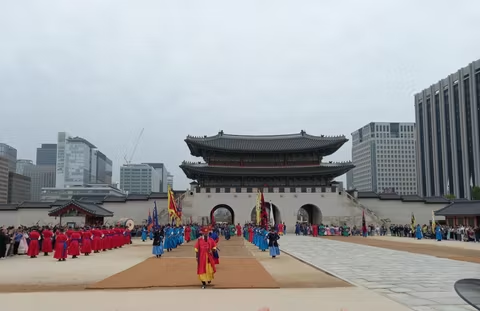
Gyeongbokgung,Bukchon,Gwangjang,N-SeoulTower,Hongdae
Gyeongbokgung,Bukchon,Gwangjang,N-SeoulTower,Hongdae
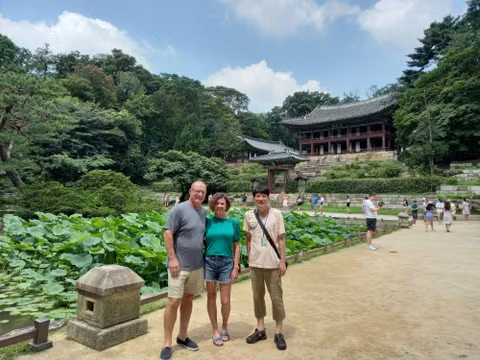
Changdeokgung, Bukchon, Gwangjang market, N Seoul Tower
Changdeokgung, Bukchon, Gwangjang market, N Seoul Tower
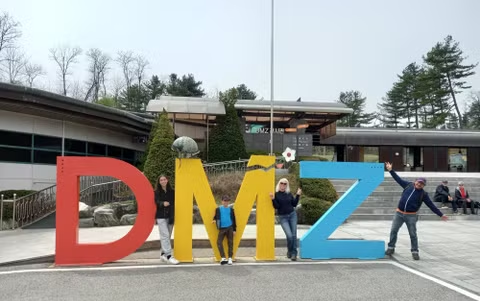
DMZ tour to 3rd tunnel, Imjingkak, Gamaksan Suspension Bridge
DMZ tour to 3rd tunnel, Imjingkak, Gamaksan Suspension Bridge
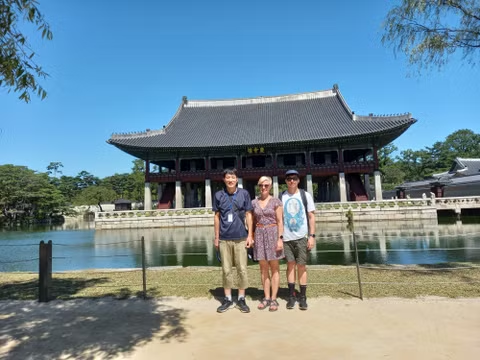
Gyeongbokgung, Bukchon Village, Gwangjang market, Folk Museum
Gyeongbokgung, Bukchon Village, Gwangjang market, Folk Museum
Other Popular Art, Culture, & Historical Tours in Seoul
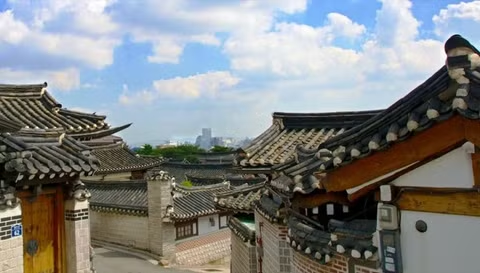
Full-day Intro to Seoul and Korean History
Full-day Intro to Seoul and Korean History
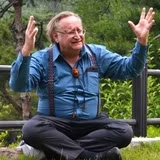
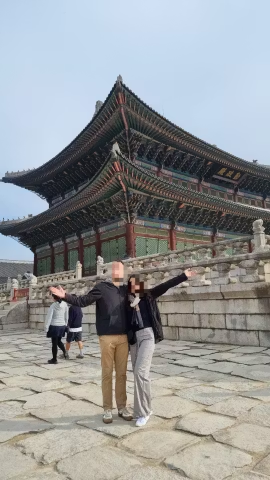
Seoul Downtown Walking Tour - the past and the present
Seoul Downtown Walking Tour - the past and the present
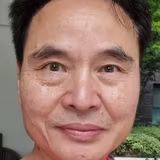
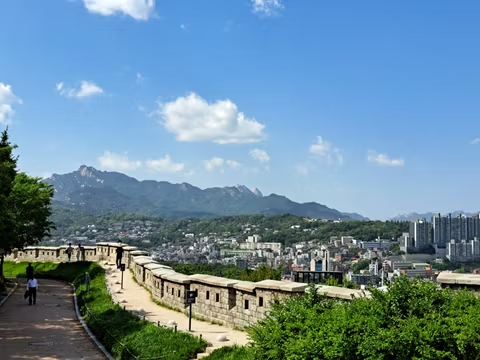
Seoul Fortress Walk: From Hidden Walls to Street Food Wonders
Seoul Fortress Walk: From Hidden Walls to Street Food Wonders
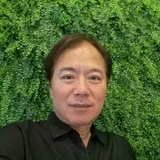
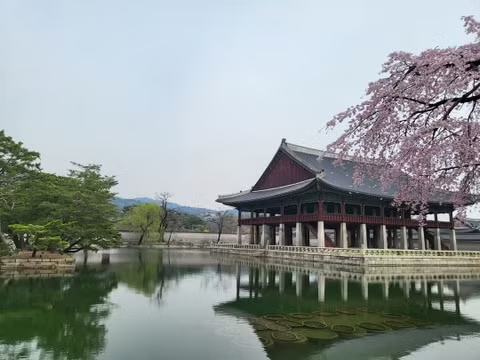
Central Seoul Walking Tour ; From Gwanghwamun Square to Ikseon-dong Hanok Alley.
Central Seoul Walking Tour ; From Gwanghwamun Square to Ikseon-dong Hanok Alley.
